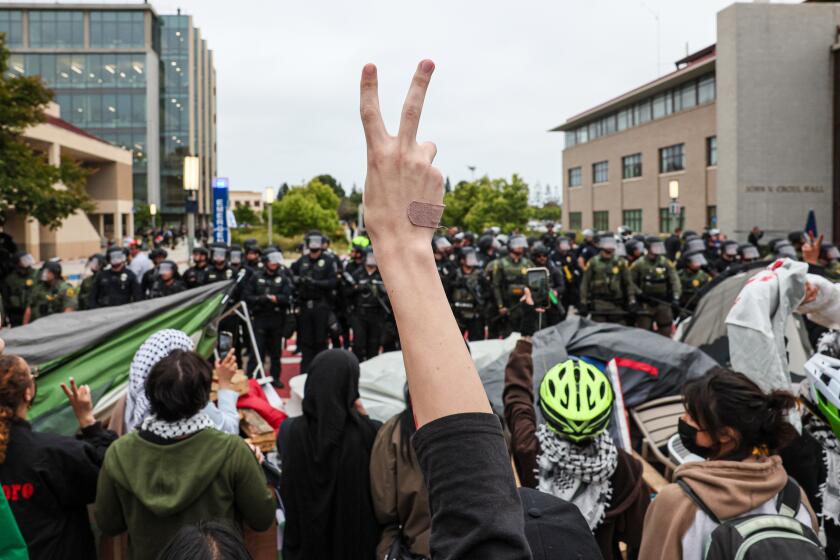Gang shooting victim must overcome pain to walk again
Four days after 10-year-old Erica Miranda was shot while playing basketball outside her home, a physical therapist walked into her hospital room and told her it was time to try to get up.
From her bed, Erica looked up at the blond woman in scrubs. She looked at her mother, who had been by her side nearly every minute since the suspected gang shooting. She looked at her stepfather, who massaged her shoulder and wiped away the tears dribbling down her cheeks.
“It’s all right, mami,” he said.
But really, it wasn’t.
Three bullets tore into Erica’s back, knee and hip on March 2 when a young man walked up to a crowded street corner in Compton and pulled out a handgun. Los Angeles County sheriff’s investigators say the shooter acted methodically, first aiming and firing at Erica, then at a 17-year-old relative of her stepfather and finally at a 45-year-old family friend. Both males were shot three times and survived.
Erica will not be paralyzed, doctors say. But there is significant nerve damage in her right leg. When the physical therapist asked her to flex her foot, she grimaced with effort and pain. Except for the tiniest twitch of the tendon in her ankle, her foot lay motionless.
A lanky fourth-grader with long black braids, Erica is a spelling bee champion and a standout on her elementary school’s basketball team. It may be months until she walks again.
Although Erica has not talked about the shooting, she knows what happened, said her stepfather, Alonzo Lemmie, 36. And she knows that she has a long recovery ahead. “Unfortunately, she gets it,” he said. “You can’t side-talk her. There aren’t too many things she doesn’t understand.”
Child victims of gang violence are not so uncommon. At a news conference Friday in which Los Angeles County sheriff’s detectives pleaded for the public’s help in identifying the man who shot Erica, they also asked for help solving another case, a March 7 drive-by shooting that sent an 18-month-old girl to the hospital with gunshot wounds to her hand and face.
Erica and her family live on the east side of Compton, in an area affiliated with the Lueders Park Piru gang. Their home is on the corner of a dead-end street lined with trees and stucco houses with gated yards.
Erica’s mother, Shameka Harris, 28, was sitting inside the house braiding a friend’s hair about 5 p.m. when she heard the pop of gunfire outside.
“I heard shots so I ran to my baby,” Harris said. “I saw my baby on the ground. I thought she was ducking. But she was shot. Then I looked down and saw all the blood on the ground. She said, ‘Mom, I can’t see. I can’t feel my legs.’ ”
The shooter fled. The two males with whom Erica had been playing basketball also lay wounded on the ground.
The 17-year-old victim may have been involved with gangs, Erica’s stepfather said. He speculated that the shooter “was maybe trying to make a statement, trying to say something.”
“But our 10-year-old daughter haven’t done nothing to nobody,” Lemmie said. “Why do you intentionally shoot kids?”
At the hospital, Erica underwent surgery on her large intestine, where one of the bullets had lodged. The operation was successful, although it left her with a colostomy bag taped to her abdomen. Doctors have told her family that they will remove it in the next several weeks.
Erica’s parents have left the hospital only a few times. At night, Lemmie sleeps in the back of his truck in the parking garage and Harris stays awake, praying, in a chair next to her daughter’s bed. Their life is now marked by new rituals -- trips to the windowless cafeteria for chili fries, walks outside to smoke. The breaks bring little relief.
“This is not a happy environment at all,” Lemmie said. “It’s sick kids everywhere. You see babies hooked up to machines. You can hear them crying.”
In Erica’s room, as a child wailed next door, the physical therapist tenderly slipped hospital socks onto Erica’s feet. You’ve been lying on your back for too long, the therapist told Erica. In order to get better later, you need to try to sit up now.
The girl listened as the therapist described how she would help her first up onto her forearms, next over to the side of the bed and into a waiting wheelchair. “Can you explain that again?” Erica asked. The woman did. And then, with the help of her parents and not a single sob, Erica began to move.
kate.linthicum
@latimes.com
More to Read
Sign up for Essential California
The most important California stories and recommendations in your inbox every morning.
You may occasionally receive promotional content from the Los Angeles Times.











